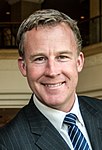| |||||||||||||||||||||||||||||||||||||||||||||||||
All 25 seats in the Tasmanian House of Assembly 13 seats needed for a majority | |||||||||||||||||||||||||||||||||||||||||||||||||
|---|---|---|---|---|---|---|---|---|---|---|---|---|---|---|---|---|---|---|---|---|---|---|---|---|---|---|---|---|---|---|---|---|---|---|---|---|---|---|---|---|---|---|---|---|---|---|---|---|---|
| Opinion polls | |||||||||||||||||||||||||||||||||||||||||||||||||
| |||||||||||||||||||||||||||||||||||||||||||||||||
 Results of the election | |||||||||||||||||||||||||||||||||||||||||||||||||
| |||||||||||||||||||||||||||||||||||||||||||||||||
The 2018 Tasmanian state election was held on 3 March 2018 to elect all 25 members of the Tasmanian House of Assembly.
The four-year incumbent Liberal government, led by Premier Will Hodgman, won a second consecutive term. It defeated the Labor Party, led by Opposition Leader Rebecca White, and the Greens, led by Cassy O'Connor. The Jacqui Lambie Network also competed in a state election for the first time, though the party did not win any seats and its leader Jacqui Lambie did not stand for election.
The Tasmanian House of Assembly (the lower house) has five divisions with five members each for a total of 25 seats, 13 of which are required for a majority. The divisions correspond in name and boundaries to the five federal electorates for the House of Representatives. The election was conducted by the Tasmanian Electoral Commission using the Hare-Clark electoral system; five candidate are declared elected once each of them reach 16.7% (one-sixth) of the total formal vote during counting.
House of Assembly elections are not tied to the election dates for the Legislative Council (the upper house), which occur in May each year for two or three of the 15 divisions, completing a fixed periodic cycle over six years.
Ultimately, the Liberals suffered a two-seat swing, but were able to hold on to a one-seat majority of 13 seats. It was the first time in 22 years that a Liberal government won a second consecutive term in Tasmania, and the first time since 1986 and only the second time since 1931 that an incumbent conservative government was reelected with an overall majority. It was also the first time a state parliamentary assembly in Australia elected a majority of female members, with thirteen women and twelve men.[1]
- ^ "Tasmania first state to return female-majority parliament". ABC News. 16 March 2018. Retrieved 16 March 2018.


